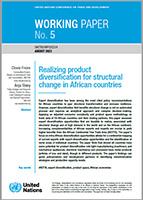
Export diversification has been among the most cited policy recommendations for African countries to spur structural transformation and increase resilience. However, export diversification that benefits structural change is not an automated process and requires an analytical approach and complex decision-making.
Applying an adjusted economic complexity and product space methodology on trade data of 54 African countries and their trading partners, this paper assesses export diversification opportunities that are feasible to realize, associated with structural change and of high demand in the world and on the African continent.
Increasing complementarities of African exports and imports are crucial to yield higher benefits from the African Continental Free Trade Area (AfCFTA).
The paper’s focus on intra-African diversification opportunities allows for a continental mapping of current exports with export diversification opportunities and the identification of niche areas of individual countries.
The paper finds that almost all countries have some potential for product diversification into light manufacturing (machinery and mechanical appliances; electrical machinery) and processed base metal products (articles of iron and steel), though in different products.
The paper’s findings can guide policymakers and development partners in identifying industrialization strategies and productive capacity needs.
The findings, interpretations and conclusions expressed in this document are those of the author(s) and do not necessarily reflect the views of the United Nations or its officials or Member States.
The designations employed and the presentation of material on any map in this work do not imply the expression of any opinion whatsoever on the part of the United Nations concerning the legal status of any country, territory, city, or area or of its authorities, or concerning the delimitation of its frontiers and boundaries.


